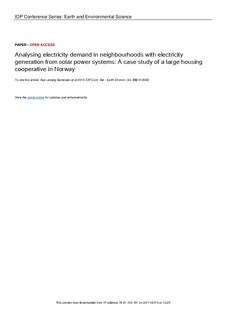| dc.contributor.author | Sørensen, Åse Lekang | |
| dc.contributor.author | Sartori, Igor | |
| dc.contributor.author | Lindberg, Karen Byskov | |
| dc.contributor.author | Andresen, Inger | |
| dc.date.accessioned | 2019-11-21T11:38:05Z | |
| dc.date.available | 2019-11-21T11:38:05Z | |
| dc.date.created | 2019-11-04T16:17:28Z | |
| dc.date.issued | 2019 | |
| dc.identifier.issn | 1755-1307 | |
| dc.identifier.uri | http://hdl.handle.net/11250/2629748 | |
| dc.description.abstract | An energy management system can be introduced on a neighbourhood level, to achieve energy goals such as increased self-consumption of locally produced energy. In this case-study, electricity generation from photovoltaic (PV) systems is simulated at Risvollan housing cooperative, a large housing cooperative in Norway. The electricity generation from PV systems of different orientations and capacities are analysed with the electricity load. Key performance indicators (KPIs) such as self-generation, self-consumption and generation multiple are described, based on hourly values. The electricity generation from the south-oriented building façade PV systems are about 5-6% higher than for the east-west oriented rooftop PV systems on an annual basis, since the façade PV systems generate more electricity in the spring and autumn. The self-consumption factor is the most important KPI in Norway, due to the national tariff structure. For the total housing cooperative, a PV capacity of about 1,000 kWp seem suitable, giving a self-consumption factor of 97% for a rooftop system, based on 2018 electricity and climate data. From the perspective of the housing cooperative, it is financial beneficial to aggregate electricity loads for common areas and apartments, since a higher share of the electricity can be used by the cooperative. For this to be possible, also housing cooperatives with PV must be facilitated for in the prosumer agreement. Comparing a single 1,100 kWp PV system providing electricity to the total cooperative with 22 PV systems of 50 kWp behind 22 garage meters, the self-consumption factor decreases from 95% to average 14%, resulting in a 41% lower financial value for the PV electricity. | nb_NO |
| dc.language.iso | eng | nb_NO |
| dc.publisher | IOP Publishing | nb_NO |
| dc.rights | Navngivelse 4.0 Internasjonal | * |
| dc.rights.uri | http://creativecommons.org/licenses/by/4.0/deed.no | * |
| dc.title | Analysing electricity demand in neighbourhoods with electricity generation from solar power systems: A case study of a large housing cooperative in Norway | nb_NO |
| dc.type | Journal article | nb_NO |
| dc.type | Peer reviewed | nb_NO |
| dc.description.version | publishedVersion | nb_NO |
| dc.source.volume | 352 | nb_NO |
| dc.source.journal | IOP Conference Series: Earth and Environmental Science (EES) | nb_NO |
| dc.identifier.doi | 10.1088/1755-1315/352/1/012008 | |
| dc.identifier.cristin | 1743940 | |
| dc.relation.project | Norges forskningsråd: 257660 | nb_NO |
| dc.relation.project | Norges forskningsråd: 701703 | nb_NO |
| dc.description.localcode | Content from this work may be used under the terms of theCreative Commons Attribution 3.0 licence. Any further distribution of this work must maintain attribution to the author(s) and the title of the work, journal citation and DOI. Published under licence by IOP Publishing Ltd | nb_NO |
| cristin.unitcode | 194,61,55,0 | |
| cristin.unitname | Institutt for arkitektur og teknologi | |
| cristin.ispublished | true | |
| cristin.fulltext | original | |
| cristin.qualitycode | 1 | |

